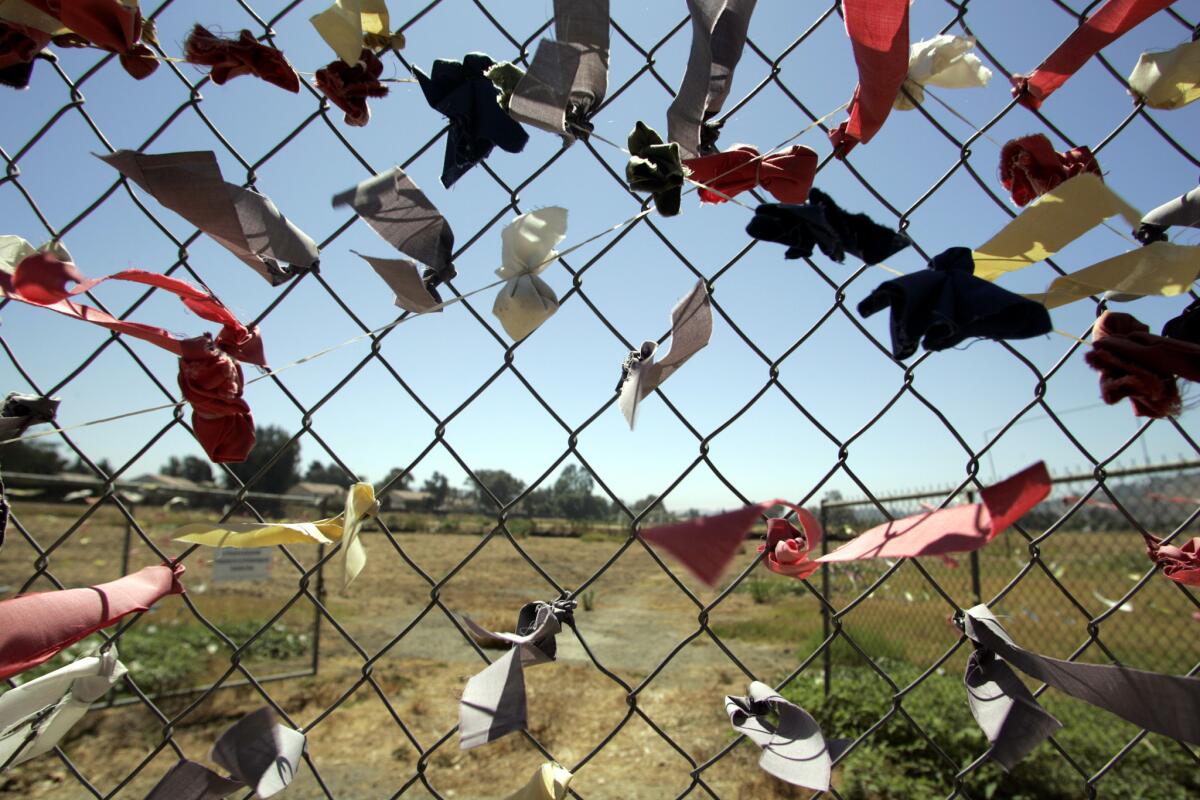After having land stolen for generations, Juaneño Indians get a sliver back

- Share via
For the Acjachemen descendants, known today as the Juaneño Band of Mission Indians, several of their sacred sites throughout San Juan Capistrano had been pillaged or desecrated. In more modern times, development encroached on the land.
But now, land is being returned — in a sense — to the tribe. It may be only 1.3 acres, and the city will still own it, but it will be turned into a public park that will include a Juaneño cultural center. Not only will the center educate the public about the tribe, but four times a year, the 1,900 tribal blood descendants will have exclusive use of the center for private prayer ceremonies — essentially a day during spring and fall equinoxes and summer and winter solstices.
Plus, they can stop paying hundreds of dollars for a permit each time they want to host a large gathering on the public property.
Most significantly, though, is the great importance that this site holds for the Juaneños.
Years back, a portion of a cemetery containing original prehistoric burials was covered with fill and developed into a ballfield and running track for a private high school. The Juaneños no longer had access to a gravesite of their ancestors, a place to honor their cultural and tribal roots.
While they have had access to this other sacred ground of their ancestors, the city is now recognizing its significant place in Acjachemen history and seemingly making a vow to protect it. The site is two miles northeast of Mission San Juan Capistrano in what was once known as Putuidem, the tribe’s mother village — the place where a clan is rooted — which dates back more than 12,000 years and was ruled by the tribe’s first female chief.
On a recent Friday morning, the Juaneños’ chairwoman, Teresa Romero, walked the grounds and remarked on how the sacred site will be a preserved place for the Acjachemen to share their tribal history and traditions with the community.
“See that?” she asked as she glances at an orange tree.
A red cotton sack tied to a branch contained a pinch of loose tobacco and sage. Blessed herbs are viewed as an expression of gratitude to the spirit world.
“It’s a gift given with the utmost respect to our ancestors,” Romero said. “Someone was here saying a prayer.”
It could be said that the prayer was answered.
“We’ve never had a piece of land dedicated to our sole use since the Spanish,” said Romero, who has governed the tribal council since 2013. “We haven’t had any land to conduct a ceremony. For the city to recognize that is tremendous. The fact that we can connect with our ancestors here is a great victory.”
::
For the past few years, San Juan Capistrano had contemplated putting a park on the 11-acre site in the northernmost portion of the city, known as the Northwest Open Space.
The idea for a cultural center evolved when the Putuidem Village Committee — made up of members of the California Native American Heritage Commission, a nine-person body appointed by the governor to identify cultural resources of special significance to Native Americans, and local tribal members — presented its vision for a park that would be used for education, celebration and gatherings for the Acjachemen.
Last month, the City Council approved the plan for the park, which is expected to cost $3 million, paid for in part through bonds.
According to city records, the park would have a paved entry road, a picnic area that could accommodate up to 150 people and a cultural area that would feature an interpretive trail, an amphitheater and a native plant habitat.
While the Juaneños seem united in their gratitude for this gesture, the tribe has been riven by disagreement over the years.
The Juaneños, who are the original inhabitants of the land that became Orange County and parts of San Diego, Los Angeles and Riverside counties, worked on forming a government structure in the late 1970s as they began petitioning for federal recognition.
With recognition, they could have their own government and qualify for benefits that include federal money for education and healthcare, land for a reservation and even the right to build a casino.
But the decades-long effort splintered the tribe into three factions, and in 2007, word came that the fight for government recognition had been denied.
The tribe had failed to document its historical roots and prove that each member descended from the same tribe that existed before the Spanish arrived.
Over the years, the three faction leaders argued about elections and other governing policies. They disagreed over whether to support JSerra Catholic High School’s plan to build athletic fields on a burial site, with two sides wanting the site to be used for a cultural center to honor tribal ancestors.
Regardless, the public park remains a triumph in the tribe’s fight for its indigenous rights, Romero said.
The land offered the tribe throughout history water from three major springs, water that brought with it fish and game for the people. But the most celebrated fact is that the Acjachemen’s first female chief, Coronne, ruled the village site, Romero said.
A statue of Coronne will be installed with a rock-and-water feature in the new park.
Park or no park, the tribe has held solstice and equinox ceremonies and puberty rituals on the site, and when not gathering for prayer, the members would gather wood to make musical instruments and reap berries from elderberry bushes growing on the land.
The fruit is thought to have healing properties.
Healing comes in many forms and for many reasons. Tribal members today seem less divided, and the park is a step forward in relations with the city.
The promise to preserve the site marks a special alliance with San Juan Capistrano, Romero said, adding that municipal leaders understood the significance of the land and how the site will help make the city unique.
::
Mayor Pro Tem Kerry Ferguson said she was gratified to help move forward what is being called the Northwest Open Space Cultural Heritage Project, considering there were a few hurdles to overcome.
Dogs, for one.
The horses were more of a motivating factor.
“It seemed upside down to me to have their cultural center so small when we had already put millions in a horse park,” Ferguson said. “This other part of the story needed to be given a space, not only for them but for us as well, because it’s a resource for the whole city and, at the same time, gives place for celebration, education, spiritual ceremony and gatherings.”
Ferguson was referring to the purchase by the city in 2010 of 116 acres of Rancho Mission Viejo to save it as open space. Several acres of the land were placed into a conservancy and used as an equestrian park.
Ferguson said she began taking up the Juaneño park project with the Putuidem Village Committee early last year and was met with challenges from people who argued that the public park would take away from other needs. Residents who used the adjacent dog park, installed five years ago, feared that the canine play area would be diminished, but it remains intact.
What’s next in the process of creating the park now that the council has given its approval?
Council members will have to approve designs prepared by the chosen landscape designer. Ferguson said she is hoping the project will be underway next year.
“It was so long overdue,” Ferguson said. “Of all the populations, our first Americans learned to to live on this land in peace before we got here. We had more to learn from them than they learned from us.”
Kathleen Luppi, [email protected]
Twitter: @KathleenLuppi
ALSO
New evidence in college student’s death may set the man convicted of killing her free
A black police chief finds his way in the era of Black Lives Matter
Kaiser Permanente nurses are preparing to strike over wages and staffing
More to Read
Sign up for Essential California
The most important California stories and recommendations in your inbox every morning.
You may occasionally receive promotional content from the Los Angeles Times.











